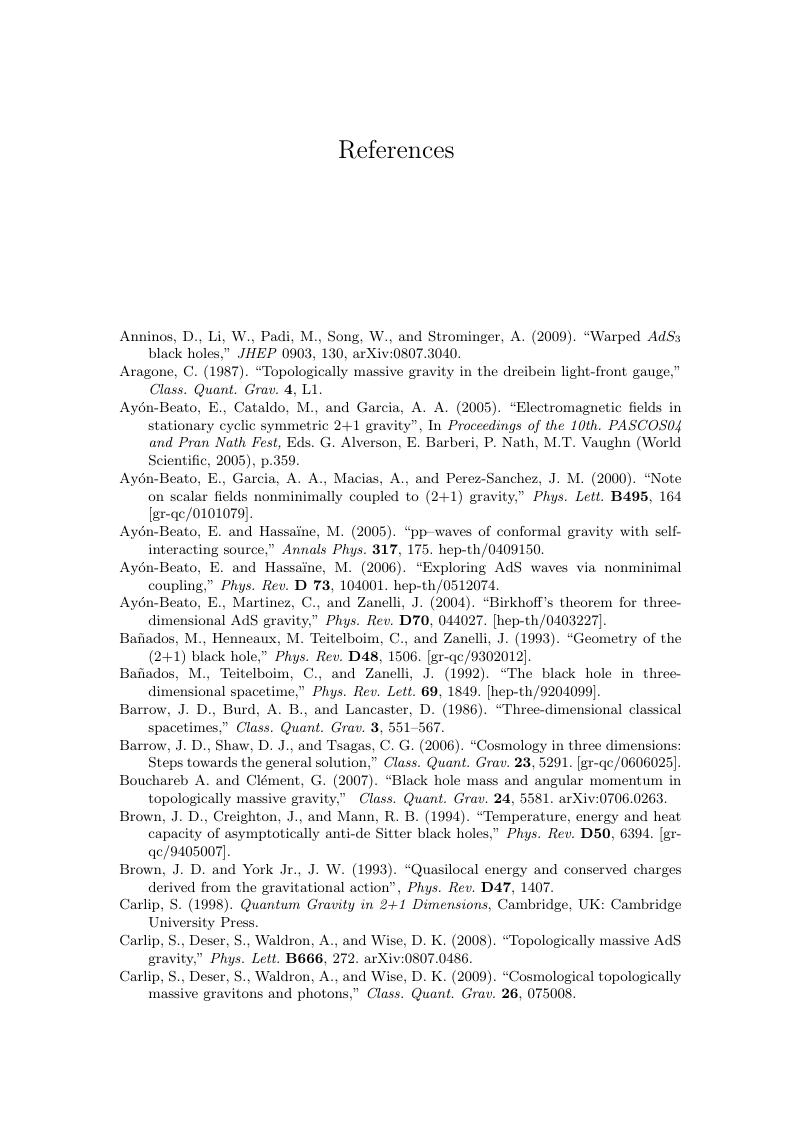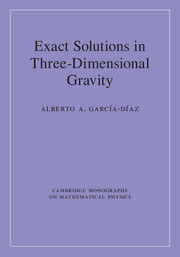Book contents
- Frontmatter
- Contents
- Preface
- 1 Introduction
- 2 Point Particle Solutions
- 3 Dust Solutions
- 4 A Shortcut to (2+1) Cyclic Symmetric Stationary Solutions
- 5 Perfect Fluid Static Stars; Cosmological Solutions
- 6 Static Perfect Fluid Stars with Λ
- 7 Hydrodynamic Equilibrium
- 8 Stationary Circularly Symmetric Perfect Fluids with Λ
- 9 Friedmann–Robertson–Walker Cosmologies
- 10 Dilaton–Inflaton Friedmann–Robertson–Walker Cosmologies
- 11 Einstein–Maxwell Solutions
- 12 Black Holes Coupled To Nonlinear Electrodynamics
- 13 Dilaton Field Minimally Coupled to (2 + 1) Gravity
- 14 Scalar Field Non-Minimally Coupled to (2+1) Gravity
- 15 Low-Energy (2+1) String Gravity
- 16 Topologically Massive Gravity
- 17 Bianchi-Type (BT) Spacetimes in TMG; Petrov Type D
- 18 Petrov Type N Wave Metrics
- 19 Kundt Spacetimes in TMG
- 20 Cotton Tensor in Riemannian Spacetimes
- References
- Index
- References
References
Published online by Cambridge University Press: 30 August 2017
- Frontmatter
- Contents
- Preface
- 1 Introduction
- 2 Point Particle Solutions
- 3 Dust Solutions
- 4 A Shortcut to (2+1) Cyclic Symmetric Stationary Solutions
- 5 Perfect Fluid Static Stars; Cosmological Solutions
- 6 Static Perfect Fluid Stars with Λ
- 7 Hydrodynamic Equilibrium
- 8 Stationary Circularly Symmetric Perfect Fluids with Λ
- 9 Friedmann–Robertson–Walker Cosmologies
- 10 Dilaton–Inflaton Friedmann–Robertson–Walker Cosmologies
- 11 Einstein–Maxwell Solutions
- 12 Black Holes Coupled To Nonlinear Electrodynamics
- 13 Dilaton Field Minimally Coupled to (2 + 1) Gravity
- 14 Scalar Field Non-Minimally Coupled to (2+1) Gravity
- 15 Low-Energy (2+1) String Gravity
- 16 Topologically Massive Gravity
- 17 Bianchi-Type (BT) Spacetimes in TMG; Petrov Type D
- 18 Petrov Type N Wave Metrics
- 19 Kundt Spacetimes in TMG
- 20 Cotton Tensor in Riemannian Spacetimes
- References
- Index
- References
Summary

- Type
- Chapter
- Information
- Exact Solutions in Three-Dimensional Gravity , pp. 421 - 429Publisher: Cambridge University PressPrint publication year: 2017



